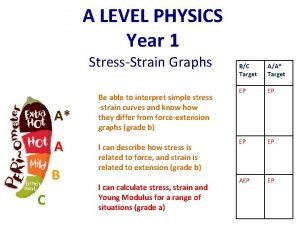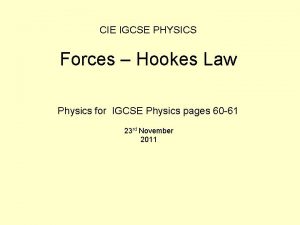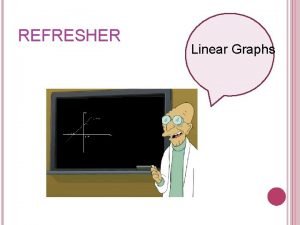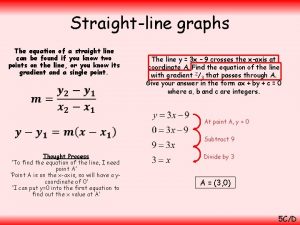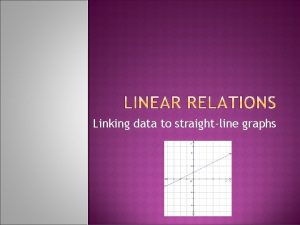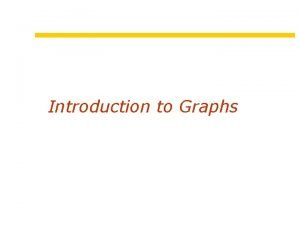Teachings for Exercise 5 H Straightline graphs Extension










- Slides: 10

Teachings for Exercise 5 H

Straight-line graphs Extension (cm) • 20 10 0 5 100 200 300 100 Mass on spring (grams) 400 Sub in values Simplify 5 H

Straight-line graphs Extension (cm) • 20 10 0 200 300 100 Mass on spring (grams) 400 5 H

Straight-line graphs Extension (cm) • 20 10 0 200 300 100 Mass on spring (grams) 400 5 H

Straight-line graphs • 0 10 30 60 100 120 19. 1 17. 8 15. 2 11. 3 6. 1 3. 5 Depth (cm) 20 15 10 5 0 20 40 60 80 Time (s) 100 120 As the points form a straight (or at least very close to straight) line, a linear model is appropriate 5 H

Straight-line graphs • 0 10 30 60 100 120 19. 1 17. 8 15. 2 11. 3 6. 1 3. 5 You can find the equation of the line from the data in the table… Choose 2 pairs of values and calculate rise/run 5 H

Straight-line graphs • 0 10 30 60 100 120 19. 1 17. 8 15. 2 11. 3 6. 1 3. 5 The y-intercept is also in the table Therefore, the equation is: 5 H

Straight-line graphs • 0 10 30 60 100 120 19. 1 17. 8 15. 2 11. 3 6. 1 3. 5 This is the change of depth per second. So every second the depth decreases by 0. 13 cm 5 H

Straight-line graphs • 0 10 30 60 100 120 19. 1 17. 8 15. 2 11. 3 6. 1 3. 5 The container will be empty when the depth is 0 Divide by 0. 13 5 H

Straight-line graphs Two quantities are in direct proportion when they increase at the same rate. The graph of these quantities is a straight line through the origin. In 1991 there were 18, 500 people living in Bradley Stoke. Planners project that the number of people living in Bradley Stoke would increase by 350 each year. There are 18, 500 people to start with It will increase by 350 people for every year Population does not increase at a linear rate (more people = faster growth), so this model may not be realistic a) Write down a linear model for the population p of Bradley Stoke t years after 1991 b) Write down one reason why this may not be a realistic model 5 H
 Flanker brand strategy
Flanker brand strategy Force extension graphs for different materials
Force extension graphs for different materials Extension load graph igcse
Extension load graph igcse Graphs that enlighten and graphs that deceive
Graphs that enlighten and graphs that deceive 5-3 polynomial functions
5-3 polynomial functions State graph in software testing
State graph in software testing Comparing distance/time graphs to speed/time graphs
Comparing distance/time graphs to speed/time graphs Confucian values
Confucian values Whi
Whi By his teachings, confucius hoped to
By his teachings, confucius hoped to Mi'kmaq colors
Mi'kmaq colors

